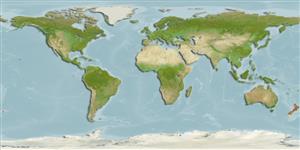>
Gobiesociformes (Clingfishes) >
Gobiesocidae (Clingfishes and singleslits) > Trachelochisminae
Eponymy: Richard ‘Dick’ Kenneth Dell (1920–2002) was Director, Dominion Museum (now Te Papa). [...] John ‘Jock’ Munne Moreland (1921–2012) was Curator of Fishes, Dominion Museum (now Te Papa), Wellington. [...] (Ref. 128868), visit book page.
More on author: Briggs.
Environment: milieu / climate zone / Tiefenbereich / distribution range
Ökologie
seewasser demersal; tiefenbereich 0 - 15 m (Ref. 9003). Temperate
Southwest Pacific: endemic to New Zealand.
Size / Gewicht / Alter
Geschlechtsreife: Lm ? range ? - ? cm
Max length : 8.5 cm TL Männchen/unbestimmt; (Ref. 27207)
Kurzbeschreibung
Bestimmungsschlüssel | Morphologie | Morphometrie
Rückenflossenstacheln (insgesamt) : 0; Rückenflossenweichstrahlen (insgesamt) : 8 - 9; Afterflossenstacheln: 0; Afterflossenweichstrahlen: 8 - 9. Head and body purple or cream with blue spots. A band of pale color across nape. Distinguished from other clingfishes by its thin lips, exposed flap of skin across the snout and a small fleshy swelling at the base of the pectoral fin.
Body shape (shape guide): elongated.
Occurs in rock pools and the subtidal zone. Usually found beneath the spines of sea urchins. Individuals too large to be associated with sea urchins usually found beneath rocks or among shell debris. Feeds mainly on the tube feet and pedicellariae of its host sea urchins, Evechinus chloroticus (Ref. 33548) and on small crustaceans.
Life cycle and mating behavior
Geschlechtsreife | Fortpflanzung | Ablaichen | Eier | Fecundity | Larven
Paulin, C. and C. Roberts, 1992. The rockpool fishes of New Zealand (Te ika aaria o Aotearoa). Museum of New Zealand (Te Papa Tongarewa). 177 p. (Ref. 9003)
IUCN Rote Liste Status (Ref. 130435: Version 2025-1)
Bedrohung für Menschen
Harmless
Nutzung durch Menschen
Tools
Zusatzinformationen
Download XML
Internet Quellen
Estimates based on models
Preferred temperature (Ref.
123201): 12.6 - 18.5, mean 16.2 °C (based on 104 cells).
Phylogenetic diversity index (Ref.
82804): PD
50 = 1.0000 [Uniqueness, from 0.5 = low to 2.0 = high].
Bayesian length-weight: a=0.00457 (0.00179 - 0.01169), b=3.12 (2.89 - 3.35), in cm total length, based on LWR estimates for this (Sub)family-body shape (Ref.
93245).
Trophic level (Ref.
69278): 3.0 ±0.1 se; based on diet studies.
Widerstandsfähigkeit (Ref.
120179): mittel, Verdopplung der Population dauert 1,4 - 4,4 Jahre. (Preliminary K or Fecundity.).
Fishing Vulnerability (Ref.
59153): Low vulnerability (10 of 100).
🛈
Nutrients (Ref.
124155): Calcium = 128 [68, 317] mg/100g; Iron = 0.486 [0.274, 0.973] mg/100g; Protein = 16.9 [15.7, 18.1] %; Omega3 = 0.472 [0.223, 1.003] g/100g; Selenium = 6.28 [2.51, 15.29] μg/100g; VitaminA = 46.3 [10.6, 191.5] μg/100g; Zinc = 1.16 [0.74, 1.75] mg/100g (wet weight);
